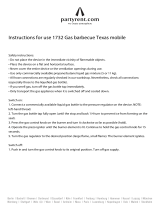Electrical connection
Cookers intended for connection to the electrical power supply are designed to work on
alternating single phase current. The total power absorbed and further technical data can
be found on the plate attached on the side of the oven door (accessed by opening the
oven door).
The appliance complies with the safety requirements laid down by the standards institutes.
Some models come with a bipolar plug with earth connection which ensures that the
appliance
is fully earthed.
The safety of the appliance is, however, dependent on the correct earthing of your power
supply. So, before connecting your appliance to the mains supply make sure that:
1) that the socket is correctly earthed
2) that the electricity meter’s amp. capacity is suitable for the consumption indicated on
the cooker’s rating plate.
WARNING: Appliances not fitted with a plug, require a fixed installation with a bi-
polar switch, which has a gap between the contacts of at least 3 mm.
The earth cable must be controllable by the switch.
The manufacturer cannot accept any responsibility when safety regulations have
been ignored.
Adapting the appliance for different types of gas
To adapt the cooker for types of gas other than for which it has been set carry out the
following operations in order.
Changing the injectors
Replacement injectors are supplied in special bags. Each injector is stamped with its dia-
meter in hundredths of a millimetre. The correct injector should be selected in accor-
dance with the instructions in the «Gas Consumption» table.
• The hob
Remove the pan supports, flame spreaders and burn-
ers and carry out the replacement through the burner
support bracket (Fig. 16) using the special spanner
supplied.
• Gas oven
Open the door and remove the oven base. Remove the
warming drawer and unscrew the fixing screws «A» lo-
cated on the upper side of the crosspiece (Fig. 17A).
Slide out the burner and replace the injector (Fig. 17B).
NB: If the oven is fitted with self-cleaning liners, they
should be removed, so that the oven base can be
removed.
WARNING: When carrying out the above operation,
check that the injectors are properly and firmly se-
cured.
Adjusting the appearance of the flame
The flame is fed by a mixture of gas and air. The air
supply has to be adjusted so that the correct mixture
reaches the burners.
To make the adjustment, carry out the following:
• Remove the grill and take out the burner.
15
• Ensure the small air regulating tubes are fitted as
shown in table K. Agood flame should be welle defined
and without yellow points (Fig. 18 position B).
If there is insufficient air, the flame will be loing and soft
(Fig. 18 position A). If this is the case, the air regulator
pipe must be moved further up the venturi tube. If there
is too much air however, the flame is short and hisses
(Fig. 18 position C) and tends to be detached from the
burner. In this case, the regulator pipe (Fig. 18 W)
should be withdrawn from the venturi tube.
The pressures are as follows:
30 mbar liquid gas; 20 mbar for methane gas, the
air
regulator pipes should be positioned on the burners
as shown in table «K».
At operation completed ensure that the screw H is firmly
secured.
• Oven. Open the door, remove the floor and slacken
the retainer (Fig. 19). Slide the regulator R by adjusting
the retainer F until a flame with the correct carburation
is obtained. To reduce the amount of air, move R in the
direction of the arrow.
Adjusting the minimum position
• The control taps (hob and oven with thermostat)
Ignite the burners and turn the control tap to minimum
position. Pull off the knob (it is just a push fit) and using
a small screwdriver turn the adjuster screws A (Fig. 20)
anti-clockwise to increase the flow of gas or clockwise
to reduce the flow, until the flame is 3/4 mm long.
• Gas oven thermostat (Fig. 21)
Having kept the oven working at maximum with the door
closed for about 10 minutes, turn the thermostat knob
to 150° C. Remove the knob and:
— if changing from methane to LPG screw in the ther-
mostat by-pass screw (Fig. 21);
— if changing from LPG gas to methane unscrew the
by-pass screw 1/4 of a turn until you get a small, regu-
lar flame.
Then, by turning the knob rapidly from maximum to
150° C, and by rapidly opening and closing the oven
door, check to see that the burner does not go out.
Tab. K
14
If not fitted, the air tube is supplied in special bag.
Rapid
Semirapid
Auxiliary
Oven
Extra-rapid
Fish burner
Without air tube
0 mm
Without air tube
6 mm opening
Without air tube
Without air tube
G30 28-30 mbar
Type
of burner
«X» quota in function of the type of gas (see fig. 18)
G31 37 mbar G20 20 mbar
9 mm
18 mm
6 mm
2 mm opening
13 mm
Without air tube
9 mm
19 mm
7,5 mm
4,5 mm opening
19 mm
17 mm
Fig. 21
Fig. 20
Fig. 19
Fig. 18
A = minimum position adjustor screws for thermostat
A = minimum position adjustor screws for normal control tap
A = minimum position adjustor screws
for safety control tap










